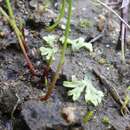Biology
(
Inglês
)
fornecido por Arkive
Liverworts, hornworts and mosses form a group of simple plants called bryophytes (2). Bryophytes lack many of the more complex structures of the higher plants, such as a vascular system, and flowers. They do not have roots, instead they have structures called 'rhizoids' which absorb water and anchor the plant to the substrate. In liverworts these rhizoids each consist of a single elongated cell (3).
Bryophytes have an interesting life cycle, which consists of two main stages, called the gametophyte and sporophyte generations, the gametophyte generation is dominant. (3). Violet crystalwort produces sporophytes towards the end of summer and into autumn, it has very large spores, and is therefore a poor disperser; spores persist in the mud until conditions become suitable for growth (2).
Conservation
(
Inglês
)
fornecido por Arkive
Violet crystalwort is a priority species under the UK Biodiversity Action Plan (UK BAP), and a Species Action Plan has been produced to guide the conservation of this liverwort (5). Plantlife, the wild plant conservation charity, has included this species in its Back From the Brink Programme, and has funded research and survey work on the species (4). Water levels should be lowered during summer and autumn at all sites supporting violet crystalwort (4).
Description
(
Inglês
)
fornecido por Arkive
Violet crystalwort is a small, flat greenish liverwort, which often has a violet or reddish tinge (2). Old parts of this narrow liverwort look 'spongy' (2).
Habitat
(
Inglês
)
fornecido por Arkive
Grows on exposed non-calcareous mud around ponds, lakes and reservoirs (4).
Range
(
Inglês
)
fornecido por Arkive
This liverwort has been recorded from 23 sites in Britain, since 1970, however, it has been found in just 8 sites (2). At present it hangs on at just two reservoirs in East Sussex, and a new population was found in 2001 in South Devon (4). Elsewhere, this liverwort occurs in Europe, where it is classified as Rare, and in eastern Asia (4).
Status
(
Inglês
)
fornecido por Arkive
Classified as Vulnerable in Great Britain (2).
Threats
(
Inglês
)
fornecido por Arkive
This species is vulnerable to the artificial maintenance of high water levels throughout summer and autumn, for example for fishing interests (2). Nitrate and phosphate pollution may also pose problems, but this is yet to be proven (2). One of the populations in southern England is seriously threatened by the invasive alien plant, New Zealand pygmy weed (Crassula helmsii) (4).
Riccia huebeneriana
(
Inglês
)
fornecido por wikipedia EN
Riccia huebeneriana is a species of liverwort belonging to the family Ricciaceae.[1]
It is native to Eurasia and Northern America.[1]
References

- licença
- cc-by-sa-3.0
- direitos autorais
- Wikipedia authors and editors
Riccia huebeneriana: Brief Summary
(
Inglês
)
fornecido por wikipedia EN
Riccia huebeneriana is a species of liverwort belonging to the family Ricciaceae.
It is native to Eurasia and Northern America.
- licença
- cc-by-sa-3.0
- direitos autorais
- Wikipedia authors and editors
Riccia huebeneriana
(
Vietnamita
)
fornecido por wikipedia VI
Riccia huebeneriana là một loài rêu trong họ Ricciaceae. Loài này được Lindenb. mô tả khoa học đầu tiên năm 1836.[1]
Chú thích
Liên kết ngoài
- licença
- cc-by-sa-3.0
- direitos autorais
- Wikipedia tác giả và biên tập viên
Riccia huebeneriana: Brief Summary
(
Vietnamita
)
fornecido por wikipedia VI
Riccia huebeneriana là một loài rêu trong họ Ricciaceae. Loài này được Lindenb. mô tả khoa học đầu tiên năm 1836.
- licença
- cc-by-sa-3.0
- direitos autorais
- Wikipedia tác giả và biên tập viên

